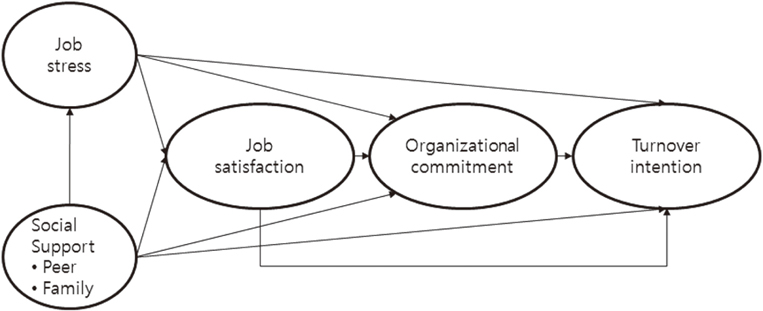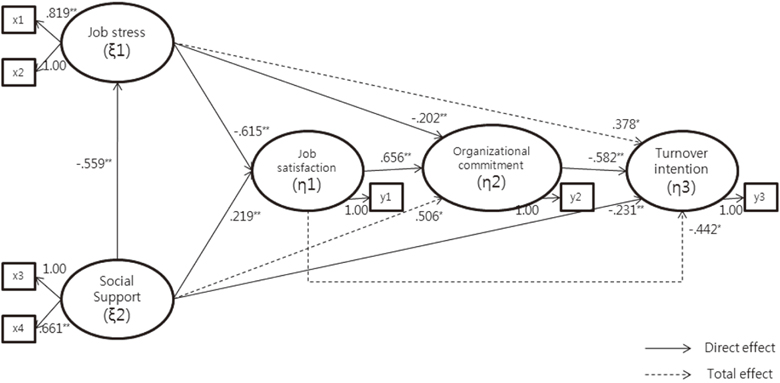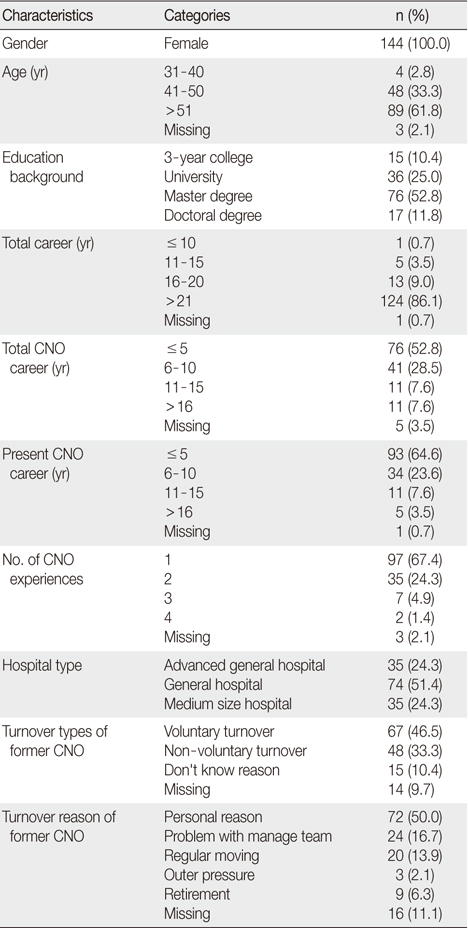Articles
- Page Path
- HOME > J Korean Acad Nurs > Volume 42(1); 2012 > Article
-
Original Article
- A Model on Turnover Intention of Chief Nurse Officers
- Kwang-Ok Park, Jong Kyung Kim, Se Young Kim, Sunju Chang
-
Journal of Korean Academy of Nursing 2012;42(1):9-18.
DOI: https://doi.org/10.4040/jkan.2012.42.1.9
Published online: February 29, 2012
1Assistant Professor, Department of Nursing, Sunchon National University, College of Life Science and Natural Resources, Sunchon, Korea.
2Assistant Professor, Department of Nursing, Dankook University, Cheonan, Korea.
3Full-time lecturer, College of Nursing, Eulji University, Daejeon, Korea.
4Critical Care Nurse Educator, Seoul National University Hospital, Seoul, Korea.
- Address reprint requests to: Kim, Jong Kyung. Department of Nursing, Dankook University, San#29, Anseo-dong, Dongnam-gu, Cheonan 330-714, Korea. Tel: +82-41-550-3893, Fax: +82-41-559-7902, jongkimk@dankook.ac.kr
© 2012 Korean Society of Nursing Science
- 780 Views
- 4 Download
- 9 Crossref
Abstract
-
Purpose
- The purpose of this study was to test the turnover intention model for chief nurse officers in general hospitals. The variables for the study included job stress, social support, job satisfaction, and organization commitment.
-
Methods
- A predictive, non-experimental design was used with a sample of 144 chief nurse officers from 144 general hospitals. Data were collected using self-administered questionnaires and analyzed using SPSS, AMOS program.
-
Results
- The overall fitness of the hypothetical model to the data was good (χ2=16.80, p=.052, GFI=.96, AGFI=.90, NFI=.97, CFI=.99). Job stress, social support, job satisfaction, and organization commitment explained 59.0% of the variance in turnover intention by chief nurse officers. Both organization commitment and social support directly influenced turnover intention for chief nurse officers, and job stress and job satisfaction indirectly influenced turnover intention.
-
Conclusion
- The results imply that chief nurse officers in hospitals need social support and management of job stress to increase job satisfaction and organization commitment, and lower turnover intention.
- 1. AbuAlrub R.F., Al-Zaru I.M. Job stress, recognition, job performance and intention to stay at work among Jordanian hospital nurses. Journal of Nursing Management. 2008;16:227–236. http://dx.doi.org/10.1111/j.1365-2834.2007.00810.x.ArticlePubMed
- 2. An S.Y., Kim H.S. The effect of family, job, and organization-related situation to turnover intention of women managers. The Women's Studies. 2009;77(2):5–48.
- 3. Bae B.L. Structural equation modeling with AMOS 17.0. 2009;Seoul, Cheongram.
- 4. Bettencourt L.A., Brown S.W. Role stressors and customer-oriented boundary-spanning behaviors in service organizations. Journal of the Academy of Marketing Science. 2003;31(4):394–408. http://dx.doi.org/10.1177/0092070303255636.Article
- 5. Chang S.J., Koh S.B., Kang D., Kim S.A., Kang M.G, Lee C.G., et al. Developing an occupational stress scale for Korean employees. Korean Journal of Occupational and Environmental Medicine. 2005;17(4):297–317.
- 6. Ha N.S., Choi J. The relationship among leadership style of nurse managers, job satisfaction, organizational commitment, andturnover intention. Journal of Korean Academy of Nursing. 2002;32:812–822.
- 7. Ha N.S., Choi J. An analysis of nursing competency affecting on job satisfaction and nursing performance among clinical nurses. Journal of Korean Academy of Nursing Administration. 2010;16:286–294.Article
- 8. Hair J.F., Black W.C., Babin B.J., Anderson R.E., Tatham R.L. Multivariate data analysis. 2006;6th ed. Upper Saddle River, NJ, Prentice Hall.
- 9. Havens D.S., Thompson P.A., Jones C.B. Chief nursing officer turnover: Chief nursing officers and healthcare recruiters tell their stories. The Journal of Nursing Administration. 2008;38:516–525. http://dx.doi.org/10.1097/NNA.0b013e31818ebf32.PubMed
- 10. Jones C.B., Havens D.S., Thompson P.A. Chief nursing officer retention and turnover: A crisis brewing? Results of a national survey. Journal of Healthcare Management. 2008;53:89–105.ArticlePubMed
- 11. Kang S.Y., Park K.O., Kim J.K. The role adaptation process of the executive director of nursing department. Journal of Korean Academy of Nursing. 2010;40:785–798.ArticlePubMed
- 12. Kim C.H., Yang S.S., Kim Y.J., Son Y.J., You M.A., Song J.E. A structural model of nurses turnover intention. Journal of Korean Academy of Nursing Administration. 2009;15:550–562.
- 13. Kim M.H., Jung M.S. The effect of head nurses' emotional leadership on nurses' job satisfaction & organizational commitment. Journal of Korean Academy of Nursing Administration. 2010;16:336–347.Article
- 14. Kline R.B. Principle and practice of structural equation modeling. 2005;2nd ed. New York, NY, Guilford Press.
- 15. Kwon J.S., Sohn I.S., Cho S.H., Han Y.H., Park K.S. A survey about work conditions of hospital nurses. 2009;Seoul, Association of Hospital Nurses.
- 16. Langford C.P., Bowsher J., Maloney J., Lillis P.P. Social support: A conceptual analysis. Journal of Advanced Nursing. 1997;25(1):95–100. http://dx.doi.org/10.1046/j.1365-2648.1997.1997025095.x.ArticlePubMedPDF
- 17. Lawler E.E. Satisfaction and behavior. 1983;New York, NY, McGraw Hill.
- 18. Lee B.S., Jung Y.S., Lee E.J., Jo E.J., Kang S.R., Ahn H.K., et al. Nursing management. 2008;Seoul, Jungdam.
- 19. Lee H., Lim J. Structural equation modeling and AMOS 16.0. 2009;Seoul, Bupmoonsa.
- 20. Marquis B.L., Houston C.J. Leadership roles and management functions in nursing: Theory and application. 2005;5th ed. Philadelphia, PA, Lippincott Williams & Wilkins.
- 21. Mobley W.H. Intermediate linkages in the relationship between job satisfaction and employee turnover. Journal of Applied Psychology. 1977;62(2):237–240. http://dx.doi.org/10.1037/0021-9010.62.2.237.Article
- 22. Mowday R.T., Steers R.M., Porter L.W. The measurement of organizational commitment. Journal of Vocational Behavior. 1979;14(2):224–247. http://dx.doi.org/10.1016/0001-8791(79)90072-1.Article
- 23. Park H.S. Relationship between perceived nursing care role orientation, job characteristics, and turnover among nurses. 2002;Seoul, Yonsei University. Unpublished master thesis.
- 24. Park J.W. A study for development of social support. 1985;Seoul, Yonsei University. Unpublished doctoral dissertation.
- 25. Price J.L., Mueller C.W. Absenteeism and turnover of hospital employees. 1986;Stanford, CA, JAI Press.
- 26. Sager J.K. A structural model depicting salespeople's job stress. Journal of the Academy of Marketing Science. 1994;22(1):74–84. http://dx.doi.org/10.1177/0092070394221007.Article
- 27. Shin Y.G. Human resource management. 2001;Seoul, Sinkwang publishing Co.
- 28. Yoon G.S., Kim S.Y. Influence of job stress and burnout on turnover intention of nurses. Journal of Korean Academy of Nursing Administration. 2010;16:507–516.
- 29. Yoon J.A., Lee H.J. Internal marketing, job stress, organizational commitment and turnover intention in nursing organization. Journal of Korean Academy of Nursing Administration. 2007;13:293–301.
- 30. Weiss D.J., Dawis R.V., England G.W., Lofguist L.H. Manual for the Minnesota Satisfaction Questionaire. 1967;Minneapolis, MN, University of Minnesota, Industrial relations Center.
REFERENCES
Figure & Data
REFERENCES
Citations

- Nurse Staffing, Work Hours, Mandatory Overtime, and Turnover in Acute Care Hospitals Affect Nurse Job Satisfaction, Intent to Leave, and Burnout: A Cross-Sectional Study
Sung-Heui Bae
International Journal of Public Health.2024;[Epub] CrossRef - Mediating effects of workgroup processes on the relationship between nurse turnover and nurse outcomes in hospitals
Sung-Heui Bae, Suin Kim, Hwasook Myung
Frontiers in Public Health.2023;[Epub] CrossRef - Relationships among Non-Nursing Tasks, Nursing Care Left Undone, Nurse Outcomes and Medical Errors in Integrated Nursing Care Wards in Small and Medium-Sized General Hospitals
Ju-Young Park, Jee-In Hwang
Journal of Korean Academy of Nursing.2021; 51(1): 27. CrossRef - Assessing the Presence of Post-Traumatic Stress and Turnover Intention Among Nurses Post–Middle East Respiratory Syndrome Outbreak: The Importance of Supervisor Support
Heeja Jung, Sun Young Jung, Mi Hyang Lee, Mi Sun Kim
Workplace Health & Safety.2020; 68(7): 337. CrossRef - The Convergence Study of Interpersonal Caring Behaviors on Anger, Job Stress and Social Support in Nurses
Jin-Ah Han, Mi-Jin Kim
Journal of the Korea Convergence Society.2016; 7(3): 87. CrossRef - Influences of Customer Orientation, Emotional Labor, Unit Manager-nurse Exchange and Relational Bonds on Nurses' Turnover Intension
Young-Soon Kim, Kyung-Yeon Park
Journal of Korean Academy of Nursing Administration.2016; 22(4): 396. CrossRef - Literature Review of Structural Equation Models for Hospital Nurses' Turnover Intention in Korea
Eunhye Kim, Jinhyun Kim
Perspectives in Nursing Science.2014; 11(2): 109. CrossRef - Effects of Nurses' Social Capital on Turnover Intention: Focused on the Mediating Effects Organizational Commitment and Organizational Cynicism
Jeongwon Han, Heeyoung Woo, Eunsil Ju, Sohee Lim, Sangsook Han
Journal of Korean Academy of Nursing.2013; 43(4): 517. CrossRef - The Effects of DISC Behavior Styles of Office Workers on Job Satisfaction, Organizational Commitment and Job Performance
Yun-Young Kim, Young-Hwa Baek, Ki-Hyun Park, Jong-Hyang Yoo, Eun-Su Jang
Korean Journal of Occupational Health Nursing.2012; 21(2): 98. CrossRef


Figure 1
Figure 2
General Characteristics of Participants (N=144)
CNO=Chief nurse officer.
Descriptive Statistics of Observed Variables (N=144)
Correlations among Observed Variables
*p<.05; **p<.01.
Effects of Predictive Variables on Endogenous Variables in the Model
SMC=Squared multiple correlations.
*p<.05; **p<.01.
CNO=Chief nurse officer.
*
SMC=Squared multiple correlations. *
 KSNS
KSNS
 E-SUBMISSION
E-SUBMISSION






 Cite
Cite

